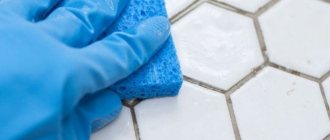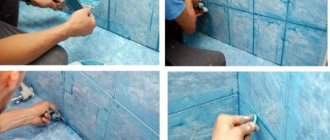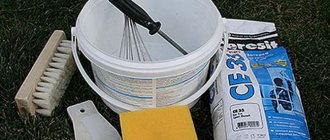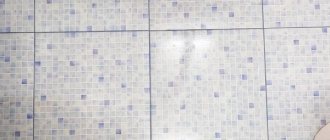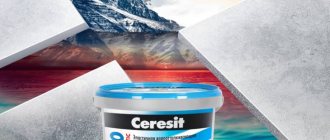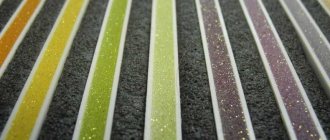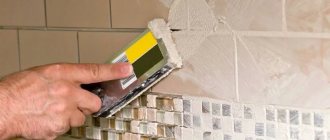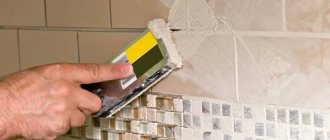Photo from the site: 1pokirpichy.ru
City residents have been accustomed to asphalt paths and sidewalks for a long time, and this material is just suitable for such places with high traffic, it is durable, durable and quite easy to clean. However, to be completely honest, asphalt does not look very aesthetically pleasing. Recently, the popularity of this type of coating, paving slabs, has exploded quite actively, which looks extremely attractive, giving streets and courtyards a special flavor, and such material can serve faithfully for many years, if you provide a technological installation process, as well as moderate exploitation. Moreover, it is worth understanding that grouting for external work will also be required, which will be the final stage of laying such paving slabs or paving stones.
Types of grout for external work
When laying tiles outdoors, sand and water are often used, compacted in several layers. But this option is not reliable, since water will seep in and the tiles will begin to deteriorate.
It is necessary to choose compounds suitable for frosty conditions for outdoor work.
The following mixtures are considered frost-resistant:
- Dry cement of gray or colored shade;
- Epoxy and furan resins;
- Silicone sealants or ready-made fugues;
- Latex.
Some craftsmen make a mixture of sand, cement, primer and putty on their sites. With this composition you can lay out a small area and at the same time save a lot on materials.
High-quality grout for outdoor tiles: types and types of materials
Photo from the site: lsmd.ru
Naturally, it is worth understanding that professional mixtures and solutions that have a clear purpose, as well as fairly high quality, simply cannot have a bargain price, but there is no choice here. Often, it depends on how well the installation process was carried out, as well as how accurately the technology for such installation was followed, and how long you can use your garden paths, sidewalks, and so on. Therefore, it is worth spending a little time and finding out what the industry offers us today in order to know exactly what to give preference to, because for your own money, and for no small amount at all, you want to get adequate materials, and stone grout for outdoor work is not at all exception.
The simplest option for sealing joints between tiles is the most common quartz river sand. Moreover, there is absolutely nothing holding it together. The sand must be sifted very carefully so that the jointing fits as tightly as possible. Washing is carried out in several stages, interspersed with pouring ordinary water. True, it is worth understanding that in those places, for example, where gutters pass, the sand can be washed out over time, which is why the tiles will last a much shorter period of time, and this option for finishing seams can hardly be called frost-resistant. It is worth paying attention to professional options if you want to make the coating as durable and reliable as possible.
Dry cement mixtures: colored or gray grout for outdoor clinker tiles
Photo from the site: pol-master.com
Most often, clinker tiles, which are essentially tiles of high strength and reliability, are used to decorate the surfaces of patios, gazebos, garden paths, and driveways. In fact, this finish looks extremely attractive, and will serve faithfully for a long time. That is why cement-sand grout is a popular material for natural stone for outdoor use, as well as for its artificial counterpart. Most often, grout is used for grouting in the form of a dry cement-based mixture, which is conveniently packaged in paper bags. Grout for stone joints on the street, for example, real granite, marble and others, should only be cement-based; polymers are not suitable here.
A wide range of colors from various manufacturers allows you to achieve the most attractive appearance, and the composition, which, by the way, can be applied no earlier than two days after laying the tiles, will reliably protect it from moisture, and at the same time prevent the growth of grass in the space between the tiles. Such solutions most often turn out to be liquid after dilution with ordinary water, and then they are simply applied to the surface, and the excess is removed with a rubber spatula or grater; everything will depend on the area of the coating itself.
Photo from website: youtube.com
Such a liquid mixture can be easily applied using a special gun, but do not be intimidated by this term. In fact, it is simply a hollow cylinder with a tip and a narrow hole, which is filled with a fugue, which then must be squeezed into the space between the tiles using a piston. Such a gun can be purchased at hardware stores, it is convenient and easy to work with, and you won’t have to spend a painfully long time cleaning the tiles from stains. The frost resistance of such mixtures is quite high, and if you do not live in the Far North, where temperatures drop to minus fifty, then there will be nothing to worry about.
Important
If you use concrete tiles or clinker tiles for the coating, the best option would be to use cement-based grout. It will reliably fasten related surfaces, prevent moisture from getting under the tiles, as well as freezing and premature deterioration of the coating.
Ready-made polymer-based grout: brick grout for exterior use
Since people most often buy dry crumbly mixtures, which simply need to be carefully and thoroughly diluted with water, few people know that street grout for brick joints, clinker, natural and artificial stone, can also be pre-diluted. This version of fugue can also be purchased quite simply; you don’t have to go through the hassle of breeding it, and it is most often sold pre-packaged in special buckets of various sizes, depending on the required quantity.
It is worth knowing that this kind of grout contains special plasticizers that cause the liquid to polymerize, giving it special qualities and properties. It becomes more elastic, but at the same time gains strength, durability, and reliability, which will last significantly. It is also important that this grout option will resist abrasion much better, which is important for those places where there is a lot of traffic during the day.
Photo from website: 71blok.ru
Among other things, it is worth clarifying, and this is not unimportant, that working with ready-made polymer grouts will greatly simplify cleaning after final hardening. That is, it will save you from the need to thoroughly wash the tiles from unsightly gray stains that inevitably remain after the cement mixture. True, there is nothing to hide, such grouting will cost much more, but spending this money really makes sense and experienced craftsmen will, without a doubt, agree with this.
Cement frost-resistant grout
They come in two types:
- On Portland cement, when the diluent is water or liquid latex. The composition is convenient to use and does not dry quickly. It is better to apply this mixture to joints no more than 5 millimeters wide.
- Mixed with sand. Grout is used for joints where the width is more than 5 mm. The quality of the resulting seam is affected by the grain size of the sand. The greater the distance between the tiles, the coarser the sand should be. The color is only gray and white. This composition is not used on the surface, as it can ruin the appearance.
Preparing sand grout is simple, although labor-intensive. The narrow joint is covered with a mixture of Portland cement and additives. Above 2 mm, cement is already mixed with part of the sand. Universal sand is used for seams larger than 9 millimeters.
A composition made only of cement is used to carry out repair work in the pool or on the terrace. The mixtures tolerate low temperatures down to -50 degrees), so they are suitable for use in the Far North and Siberia.
Which grout should I choose?
In general, information about choosing a grout can be easily read in the instructions. There are no special restrictions on the use of different types of grout: each type can be used for any tile. The only thing is that the mixture with sand can scratch glazed or marble tiles.
The packaging with grout indicates not only the type of tile for which it is suitable, but also the size of the joints, as well as the features of the room. In order not to miss a purchase, you need to take the time to read all the information and only then go to the checkout.
For seams in a bathroom, shower or swimming pool, you need to buy moisture-resistant grout (this information is always on the package).
For tiles laid on the porch or outside, it is worth choosing the most reliable option. Usually they choose trusted manufacturers: Litokol or Mapei .
In general, choosing a grout for a non-professional is not an easy task. A huge number of manufacturing companies offer their products. In the hardware stores themselves, salespeople are often “fed” to recommend a certain brand of grout, regardless of whether it is actually good or not. The easiest way is to entrust the choice of grout to practicing craftsmen who will lay the tiles. They constantly work with different materials and have already tested a huge number of mixtures in practice.
Experts know how grout behaves under different conditions. They will tell you what is better to buy for the street and what for the shower. In addition, sealants may be needed for hard-to-reach and difficult areas.
Furan and epoxy frost-resistant grout
The epoxy composition contains two components: a hardener and a resin. Pigment is also added to it for coloring. The advantage of this grout is that it can be diluted immediately before use and in the required quantity. The downside is that the mixture will only be black.
Furan grouts are used in industrial enterprises where it is necessary to equip premises.
This substance is not suitable for home use, as it is inconvenient to work with. The quality of the furan composition is considered good and has the same characteristics as epoxy resins.
Features of application
To work with a two-component composition, you will need to purchase a cleaning agent to remove residual material, plaque and buildup. Anyone can work with silicone and cement grout without any problems, but epoxy grout requires special skills and it is better to invite a specialist. Without work experience, there is a high risk of mistakes, which will become factors in obtaining rough seams with sagging.
The applied composition is elastic and is not so easily leveled with a spatula. For this purpose, it is better to use a sponge. Epoxy-based grout has a rough surface because it contains sand fractions. Particles can be large or small, which you need to pay attention to when purchasing.
Silicone sealants
Such mixtures are used in swimming pools where there is constant contact with water. Silicone adheres well to any materials.
- Holds screeds up to 7 mm wide well.
- Grout is applied to the joints between mosaic glass, ceramics, and stone, but it is not compatible with wooden surfaces and metal.
- After hardening, the sealant becomes elastic and does not allow water and moisture to pass through.
How to fill the seams of concrete paving slabs with natural sand
Natural sand
is fine sand. When pouring, it is important that it is clean, dry and free of salts, organic materials and clay impurities. You should not give preference to coarse sand, as this will not stay in the tile joints for a long time. Choose sand with a grain size of up to 1.5 mm.
1439 rub. per sq. m.
Old Town Landhaus Braer 60 mm Pride
Go to catalog
Using washed sand to fill the seams of paving slabs
It is important to consider that seams filled with natural sand:
- allow water to pass through;
- grass can grow in them;
- possible weathering and leaching from the seams;
- Over time, the joints will need to be refilled.
Otherwise, there will be no problems with sanding the seams. This method is environmentally friendly, inexpensive and does not require much effort.
Sequence of filling seams with natural sand
- After the paving slabs have been laid and the covering has been compacted with a vibrating plate, sand is poured onto its surface.
- Sand is swept over the entire surface of the paving with a brush and driven into all seams evenly and tightly, binding the coating into a single whole.
- Afterwards, the coating is re-compacted with a vibrating plate.
- Then another layer of sand is applied.
- The second layer of sand should be left to lie on the surface for a while, then sweep the area with a brush again.
Pros and cons of frost-resistant grouts
Since hardware stores offer a large selection of tile sealants, both their positive and negative properties can be considered based on the type of mixture.
But if we talk in general about the frost-resistant composition, then the following advantages stand out:
- They repel water, do not absorb moisture, so black spots of mold and mildew do not appear on them;
- If you choose the right grout, then after application it will not fade under the influence of sunlight, the color will remain for a long time;
- Resistant to temperature changes;
- Does not deteriorate from mechanical impact;
- Wide range of products.
If you apply the mixture to the seams correctly, following all the working rules, the grout will tighten the joints between the tiles for a long time.
Frost-resistant grouts also have some disadvantages:
- The price for such products is high;
- Special tools are required for the job;
- You must follow all steps according to the instructions.
If the work plan is complex, then it is better to seek help from specialists. This will help save energy and prevent the occurrence of inconvenience associated with the actions.
Color solution
You can add color pigments to the compositions yourself, but as a result the color may turn out dull and not meet the requirements. In this case, you can buy grout of the desired color from hundreds of different options. Professional compositions are colored evenly and are many times superior to materials prepared by hand.
The color selection is usually presented in store displays in a fan-shaped display with stickers. Small sticks can be taken and compared to tiles. In this case, there are different types of colored grout - cement (including with additives) and epoxy.
You can choose grout with effects. However, this solution is only available for epoxy composition. They cost more, but they look really attractive. The simplest pearlescent color is achieved by mixing regular grout with a pearlescent additive. You can also get unusual gold and glow-in-the-dark solutions.
Famous brands of frost-resistant grout
Before going to a specialty store, you should familiarize yourself with the grout manufacturers. Which ones have durability and quality.
The following companies are considered the most popular:
- The leading company Ceresit, which has been producing various construction materials and tools for more than 100 years. The company is known for its high-quality two-component compositions with antibacterial and water-repellent properties. The frost resistance of grouts is also high.
- Atlas, which is relatively new to the market, since 1991, is already considered the largest company. Finishing and building materials are produced here. The company offers many types of grout: from cement grout with various additives to epoxy. The company is a developer of some types of frost-resistant grout with protection against bacteria.
- The German company Sopro has been known for a long time; it has a rich, centuries-old history. It is this company that supplies compounds for outdoor work to construction markets. Glitter and some shades are added to epoxy and cement to add beauty. The company offers its customers quick-drying grout, as well as various tools for removing old grout.
When assessing the quality of grouts, it is necessary to carefully study their features and what the principle of working with them will be. For example, silicone and cement mixtures will not cause any difficulties; you can work with them yourself.
But epoxy grout requires certain skills and knowledge, so it will be a lot of difficulties if you do the work yourself. Therefore, before you start laying tiles, you should evaluate your capabilities.
What functions do seams perform?
A special feature of paving slabs is the presence of a large number of seams.
The performance, durability and aesthetics of the entire coating depend on the quality of workmanship and the condition of the seams. The seams between paving slabs perform the following functions:
- Ensure the design position of paving stones in the coating.
This is especially true for clinker or granite paving stones. Due to the fact that the geometry of products can be quite different, deviations in product dimensions are leveled out using seams.
4807 rub. per sq. m.
Clinker paving stones Stroeher 240x52x18 mm 124
Go to catalog
Laying German clinker tiles Stroeher with an 8 mm seam
- Prevents damage to paving slabs.
Laying tiles without seams is not allowed, as this leads to damage to the tiles as a result of force or temperature deformations. In vibropressed tiles, this is also facilitated by concrete joint formers or “rusts” on the side surface of the products.
1438 rub. per sq. m.
Old Town Choice 60 mm Stepnyak
Go to catalog
Joint formers on the side surface of paving slabs
- Distribute horizontal forces from loaded elements to adjacent ones.
Using the joint filling material, the paving slab covering is bound into a single whole. For example, when a car brakes, neighboring tiles are included in the shift work.
Professional laying of paving slabs
Read more
- Provide water permeability or impermeability of the coating.
This depends on the method of water drainage: from the surface or through the drainage base. Its durability depends on how well water is drained from paving slabs. Otherwise, moisture will penetrate into the paving slabs, freeze and destroy them in winter.
Schematic diagram of the operation of permeable grout and drainage base
- Perform an aesthetic function.
Using the color of the grout, you can achieve various visual effects and emphasize the geometry of the tile. Properly executed seams prevent the growth of weeds. There are also “green seams” with specially planted lawns.
Decorative “green” seams in paving slabs
Photo of frost-resistant grout for tiles
How to choose grout color?
There is no need to philosophize here. Everything has already been invented. There are two options:
- Grout to match the color of the tile;
- Contrasting option.
Grout: matching the tiles and contrasting
The easiest way is to choose a shade of grout so that it matches the color of the tile. Choosing a contrasting tone is a more responsible task. If you lay, for example, yellow tiles and choose red grout, then this tandem will not look advantageous if there are no other red elements around. The tiles do not lie on their own; there are other interior items around with their own color schemes. Everything together should form a coherent composition.
If all the walls are completely tiled with contrasting grout, then you shouldn’t do the floor in a similar way. It will be too harsh and clumsy.
Contrast: either on the walls or on the floor
Often in the interior of a bathroom a combination of several colors of tiles is used on one surface. Modern design projects involve the use of two or more colors of tiles on the wall. This is a bold step in itself, so it is very important to be especially careful with the choice of grout, especially if the tiles are laid in two contrasting colors. The easiest way is to use one shade of grout for two tile colors . For one of the colors the grout will be in tone, and for the other it will be contrasting. For example, if chocolate and light beige colors are adjacent, you can use light grout. It will fit well with both tiles and will also “make friends” with each other. If your bathroom combines black and white tiles, you can choose either black or white grout.
One grout for two tile colors
For white tiles, you should choose either a completely contrasting option or a boiling white grout. Beige, pale gray and similar grout colors on white tiles will look dirty and untidy. At the same time, the snow-white grout on the floor will very soon lose all its whiteness and will also look sloppy. It's better to save it for the walls.
You can adopt the Scandinavian tradition: there, the seams of white tiles in the bathroom and toilet are usually grouted with a dark gray compound. This is explained by practicality considerations: white grout in the bathroom can quickly turn yellow. Walls with gray grout are much easier to maintain.
How not to make a mistake with colored grout?
Many people are faced with the fact that the shade of colored grout after drying is very different from the sample in the store and from the color printed on the package. If you are willing to spend extra money, purchase grout in a small package and do a test batch. Fill the joints between the tiles with grout, which will subsequently be hidden by furniture or appliances. Evaluate the result after complete drying. Please note that colored grout becomes noticeably lighter when it dries. If you are not at all happy with the color, you can buy and test another grout.
But what to do if all the seams are worn out and the grout color doesn’t suit you? You can carefully paint the seams using a brush. The paint should be moisture-resistant and tinted to the desired color. To avoid staining the tiles, you can insulate them with masking tape.
